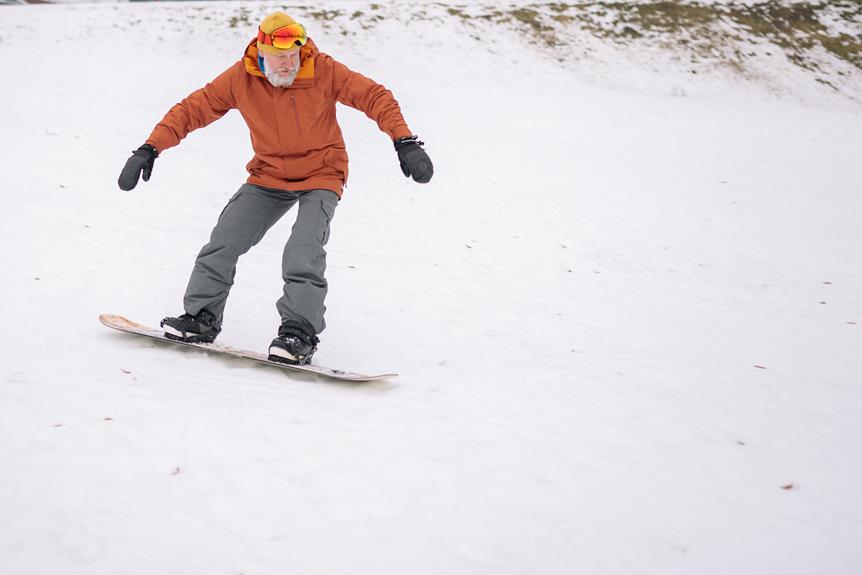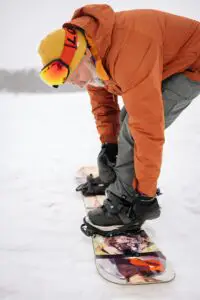Before hitting the slopes, it’s essential to balance thrill with safety.
Wearing proper gear and learning safe falling techniques can make snowboarding enjoyable and responsible.
Essential Protective Snowboarding Gear
When snowboarding, essential protective gear like helmets and wrist guards safeguard against injuries from falls.
Butt pads, knee pads, and elbow pads also reduce the risk of serious injuries by providing additional protection for your lower and upper body.
Helmets
Before snowboarding, ensure you wear a helmet for crucial head protection. A helmet reduces the risk of injuries by absorbing impact and providing coverage. Choose a snowboarding-specific helmet with safety certifications for effectiveness.
Even experienced snowboarders should prioritize safety due to unexpected obstacles. Wearing a helmet proactively safeguards against potential injuries, allowing you to enjoy snowboarding with peace of mind.
Wrist Guards
Protect your wrists with sturdy wrist guards to prevent fractures and sprains while snowboarding. Wrist guards provide support and stability during falls, absorbing and distributing impact force.
Snug, properly fitted wrist guards allow natural movement while ensuring protection. Consistent use is essential, as even minor falls can cause wrist injuries.
Butt Pads
When snowboarding, prioritize impact protection and comfort by selecting quality butt pads. These pads offer sufficient padding and absorption to protect your tailbone and hips from hard landings, reducing the likelihood of painful injuries such as bruising or fractures.
Ensure the pads fit snugly under your snowboarding pants to prevent discomfort during movement. Prioritizing safety gear like butt pads is crucial for a safe snowboarding experience.
Knee Pads
Protect your knees while snowboarding by wearing knee pads to reduce the risk of injuries during turns, jumps, and falls.
Choose pads that fit comfortably under your pants, with durable outer shells and cushioned inner layers to absorb impact.
Invest in high-quality knee pads designed for snowboarding to ensure worry-free and enjoyable experiences on the slopes.
Elbow Pads
When snowboarding, wearing elbow pads is crucial for protecting your vulnerable joints from impact injuries. Elbow pads absorb and distribute impact force, reducing the risk of fractures, bruises, and abrasions.
They provide confidence to navigate the slopes comfortably and safely, allowing for a full range of motion.
Invest in high-quality elbow pads to enhance your snowboarding experience and prioritize safety.
Goggles
When snowboarding, wear goggles for protection against snow, wind, and UV rays.
Goggles reduce the risk of injuries by providing a barrier against wind, cold, and flying snow. They also offer UV protection, shielding your eyes from harmful sun rays that can cause snow blindness.
Glove
When snowboarding, a good pair of gloves is essential to protect hands from cold, moisture, and potential injuries. Quality gloves maintain warmth and dexterity, offering waterproof, breathable, and non-bulky insulation.
Look for gloves with a good grip for securely holding equipment, and wrist leashes to prevent loss. Gloves also provide protection in case of injury, ensuring an enjoyable and safe snowboarding experience.
Snowboard Lessons for Beginners and Intermediate Snowboarders
Enhance your snowboarding skills and confidence with beginner or intermediate lessons.
Professional instructors offer guidance, teaching proper techniques and safety measures for navigating slopes.
Lessons accelerate skill development, building a strong foundation and boosting confidence in your abilities.
Snowboard Safety FAQs
If you’re curious about snowboarding safety, let’s address these common concerns to ensure a safe and enjoyable snowboarding experience.
The best protective gear is essential for snowboarding. Wearing a helmet is the most important piece of gear to protect your head from potential injuries. It’s also important to wear proper snowboarding boots that provide ankle support and prevent foot injuries. Additionally, wearing wrist guards can help prevent wrist injuries, which are common in snowboarding.
Injury prevention is crucial in snowboarding. It’s essential to warm up before hitting the slopes to loosen your muscles and prevent strains or sprains. Learning proper snowboarding techniques and taking lessons can also help prevent injuries. Finally, it’s important to be aware of your surroundings and follow the rules of the mountain to avoid collisions with other snowboarders or skiers.
How dangerous is snowboarding
Snowboarding poses risks, especially without proper safety measures. Head injuries from falls or collisions are a serious concern.
To stay safe, always wear a well-fitted helmet that meets safety standards.
Prioritize safety for an injury-free snowboarding experience.
What protective gear is best for snowboarding
When snowboarding, wearing the best protective gear is crucial for safety. A snug, certified helmet prevents head injuries.
Wrist guards protect from fractures and sprains in case of a fall.
Goggles shield eyes from wind, snow, and harmful UV rays.
Well-fitted snowboard boots provide ankle support, preventing lower leg injuries.
Additionally, a face mask or balaclava shields the face from cold and potential impacts.
Prioritizing the right gear ensures safety on the slopes.
How to avoid injuries while snowboarding
When snowboarding, maintaining proper body positioning and balance is crucial for controlling your movements and avoiding injuries. Keep your knees slightly bent and your weight centered over the snowboard to enhance balance and maneuverability, reducing the risk of falls and collisions, and minimizing head injuries.
Stay alert to your surroundings and maintain control, especially in crowded or unfamiliar areas, to avoid unexpected obstacles and other riders, reducing the risk of accidents and injuries.
What are common snowboarding wounds
Snowboarding injuries like wrist fractures, shoulder dislocations, and ankle sprains are common due to the nature of the sport. Riders often instinctively use their hands to break a fall, leading to wrist fractures, while hard impacts or awkward landings can cause shoulder dislocations. Ankle sprains occur from twisting motions during snowboarding.
To prevent these injuries, wearing wrist guards can protect against fractures, practicing proper falling techniques can reduce shoulder dislocations, and strengthening ankle muscles and using supportive boots can lower the risk of ankle sprains.
Understanding these potential injuries is crucial for taking proactive steps to stay safe while enjoying snowboarding.
Why should I wear a helmet snowboarding
When snowboarding, wearing a helmet is crucial for protecting your head from injuries. A helmet reduces the risk of head injuries, including concussions and skull fractures, by absorbing impact.
Prioritize safety by always wearing a helmet while snowboarding to prevent serious head injuries.
How to size snowboard protection
When sizing your snowboard protection gear, ensure a comfortable and secure fit for safety on the slopes. Measure head circumference at eyebrow level for the right helmet size. Use a tape measure to determine body part circumference for wrist, knee, and elbow protection.
Follow manufacturer’s sizing guidelines and seek professional guidance if unsure. Properly sized gear greatly reduces injury risk and enhances the snowboarding experience.
How to fall safely snowboarding
To minimize injury risk while snowboarding, focus on mastering the technique of controlled falls. Keeping your knees bent helps absorb the impact and maintain better balance. Rolling with the fall distributes the force and reduces the risk of injury.
Highly rated snowboard helmets
Invest in a highly rated snowboard helmet for essential head protection on the slopes. Look for ASTM F2040 or CE EN 1077 certifications for safety standards.
Consider MIPS technology for rotational impact protection and adjustable ventilation for temperature regulation.
Prioritize helmets designed specifically for snowboarding to reduce head injury risk while enjoying your time on the slopes.
Crash proof snow pads for sale
When purchasing crash-proof snow pads for snowboarding, prioritize durable materials like EVA foam or polyurethane for optimal protection.
Verify safety certifications such as CE or ASTM to guarantee effectiveness in preventing injuries.
Conclusion
When snowboarding, wearing the right gear and getting proper training is crucial for safety.
Enjoy the thrill of snowboarding confidently by prioritizing prevention.




